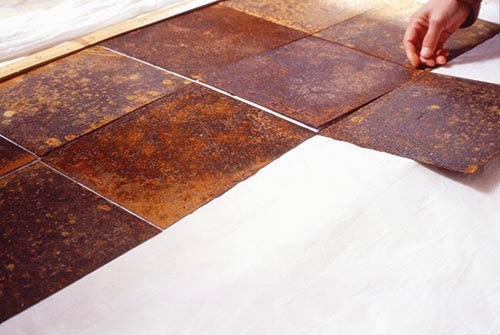Workshop - Ingenious Pattern - Rust and Itajime
[2014 Symposium registration opens June 23 at 10am.]
2014 Maiwa Textile Symposium
Workshop Ingenious Pattern - Rust and Itajime
Prof Masayoshi Ohashi and Reiko Sudo
$295 includes 60 lab fee
September 4, 5 - Class Limit 16
Maiwa East: 1310 Odlum Drive, Vancouver BC
This workshop teaches two separate techniques: rust dyeing and itajime clamp resist.
Rust Dyeing: rust comes from within. So says a Japanese proverb. But there is a sublime, extraordinary potential in the colours made as iron oxidizes.
When the process of rust is creatively combined with textiles, a beautiful world of texture and possibility is created. This world has been thoroughly explored by master textile designer Reiko Sudo. In this workshop Reiko will take students through the process that she herself has used to create her fantastic exhibition work “Scrapyard.”
Itajime Clamp Resist: Archaeologists have found scraps of tie-dyed cloth at ancient sites the world over. The basic idea is so simple. Shibori techniques seem to have occurred quite naturally to people at independent places and times (perhaps from observing how tightly twisted or knotted items stayed dry even when soaked). Methods gradually diversified as they spread. Equally widespread, methods of extracting colour from plants and other natural materials to dye yarns and cloth have been around since ancient times.
The two notions were easy to connect: water could carry beautiful colours almost anywhere, but how to stop it from staining certain places so as to make patterns? Constricting kept fibres dry where pressed tight, so why not tie threads and fabric selectively to resist dyeing?
In Japan, shibori dyeing traces back to the 6th or 7th century. From the Edo period (1600s) into the early modern Meiji era, a boom in indigo dyeing also encouraged the development of many different indigo shibori techniques. One of them is itajime-shibori “board-clamped dyeing” whereby cloth is folded up and pressed between squared or triangular boards, then dipped in dye baths to yield beautiful geometric patterns.
From Japan, the country of origami paper folding, we bring you an original way to dye fabric. This is a rare opportunity to connect with the lineage of Japanese master artisans. The course is co-taught by Reiko Sudo, of the famous Nuno Corporation, an innovator in fabric design, and Professor Masayoshi Ohashi, who studied under the direct lineage of Japan’s first Living National Treasure, Keisuke Serizawa.











0 comments
We moderate comments to keep posts on-topic, avoid spam, and inappropriate language. Comments should appear within 24 hours.